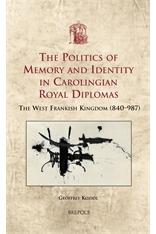Historians turn to diplomas, the authoritative documents issued by a ruler, to flesh out the legal and administrative “plot” of the past. In this month’s Berkeley Books selection, The Politics of Memory and Identity in Carolingian Royal Diplomas: The West Frankish Kingdom (840-987), Professor of History Geoffrey Koziol points out that diplomas make good sources not only because they have survived but because they were constructed to serve precisely that purpose.
Through “semantic excavation,” a modern historian reads the interpretative acts of the Carolingians themselves, the agendas and linguistic choices that informed their royal narratives. Koziol seeks to understand the events of the ninth and tenth centuries “not in our terms but in theirs,” finding the conflicts between the Frankish principalities less a result of self-serving ambition but of competing claims over the principles of authority and the types of legacy enshrined in diplomas. As the older models of unity based on the king’s body or on fraternitas (brotherhood) began to corrode during the civil war following the death of Louis the Pious, an alternate model, amicitia—the voluntary creation of ties though marriage and then a legitimate heir—offered a new way to imagine the unity of the kingdom through the kinship represented in the diplomas.
Diplomas were transactions, argues Koziol, a visible form of the “political liturgy” that reinforced the dense network of patronage among the Carolingian kings and powerful magnates. Through a detailed analysis of the language and the context underwriting the diplomas of the Frankish kingdom, the chapters in Part One, “Instruments of Power,” show that these were composed to identify both the key parties and, via omission, the enemy. Looking beyond the content or the facticity advanced by the diplomas, Koziol emphasizes the performative, illocutionary force of the royal diplomas; for example, how patterns in the way diplomas were issued and received by monasteries reveal political goals behind monastic endowments, or how favor and recognition in Charles the Bald’s diplomas were meant to display the monopoly of power enjoyed by his coteries. These were crucial functions since the ‘palace’ of this king was to be found not in a place but in the sphere of influence operating around him.
As much as diplomas confirmed alliances, they also erased signs of conflict in the service of bolstering the legitimacy of successions, especially as royal authority declined after the death of Charles the Bald. Throughout Part Two, “The Footsteps of Kings,” Koziol stresses his interest in the individual mind expressing itself behind the formalized language of the diplomas. He draws a surprisingly poignant portrait of Charles the Simple iterating the diplomas of his grandfather Charles the Bald in an attempt to provide a coherent vision of the legacy of the kingdom in the face of imminent deposition. Charles the Simple’s diplomas eloquently memorialize those of his predecessor’s diplomas best suited to legitimize his own rule: by referencing, the present diplomas identified their actions as the fulfillment of the past ones. The meaning of “memory” in Koziol’s account of the Carolingian dynasty thus extends beyond commemoration or mnemonics to deep, almost sentimental attachments and enmities forged and handed down through written documents.
The book is also about how history comes to a historian. Koziol begins by describing how the broader debates in twentieth-century medieval historiography between ‘formalist’ and ‘contextualist’ readings opened up the understanding of diplomas from state documents to artifacts of social history. The Politics of Memory and Identity thus combines the concrete historical detailing of revisionist practices with the analytic rigor of canonical diploma scholarship. The incredibly labor-intensive, ascetic methods of the discipline—going back to Jean Mabillon’s rules, established in 1681, to distinguish authentic diplomas from forged ones—constituted the modern practice of history as both the study of the past and the critical examination of sources. The reception history of diplomas thus tells a story of how the idea of a “source” developed in the first place (owing much, no doubt, to the Carolingian finesse in the strategic deployment of charters as sources appropriate for constructing dynastic legitimacy).
Kathryn Dutton’s thorough review in the Institute of Historical Research identifies Koziol’s ability to fully synthesize relevant historiographical traditions, especially the work of German historians, as a key strength of the study. She considers the work “particularly useful for historians who share his concerns and questions but who work on different periods.” Though the book’s “uncompromising approach, sheer size and complex structure make it a challenging read,” it is, in her words, “Koziol’s magnum opus.”
Visit the Biblio-file to see nine texts that shaped Professor Koziol's thoughts while working on The Politics of Memory and Identity.
Sookyoung Lee is a Graduate Student Researcher at the Townsend Center for the Humanities.
